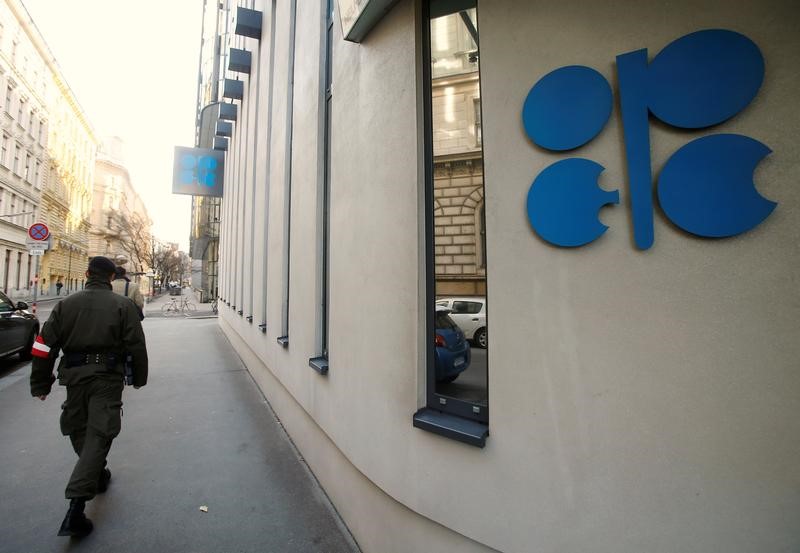Intel stock spikes after report of possible US government stake
(Bloomberg) -- Crude supplies from OPEC’s Middle East oil exporters fell to their lowest level since OPEC+ output cuts were introduced in January 2017 after an attack on two of Saudi Arabia’s largest oil processing facilities halted more than half the country’s oil production.
Saudi Arabia, Iraq, Kuwait, the United Arab Emirates and Iran, which together account for about three quarters of OPEC’s entire production, shipped an average of 14.81 million barrels a day of crude and condensate in September, tanker tracking data compiled by Bloomberg show. That was a drop of 736,000 barrels a day from August.
Although Saudi Aramco said it did not miss any shipments to customers due to the attacks, observed flows from Saudi oil terminals were down month on month by 394,000 barrels a day, or 6%. The additional shipments needed to meet the kingdom’s commitments to its customers may have come from stockpiles built up in Rotterdam, Sidi Kerir on Egypt’s Mediterranean coast and the Japanese island of Okinawa. Shipments of crude from Saudi Arabia to Egypt, where the kingdom has storage tanks, fell by more than 500,000 barrels a day, or almost 56% in September.
Kuwait was the only country to have increased shipments in September. Kuwait Petroleum Corp. offered extra shipments to at least two Asian refiners in the days immediately after the Sept. 14 attack on Saudi oil facilities.
Iraq’s exports from its Persian Gulf Basra Oil Terminal fell by 119,000 barrels a day to 3.41 million, after Oil Minister Thamir Ghadhban pledged to adhere more closely to the target agreed under the latest OPEC+ deal. The country will make further cuts in October, Ghadhban said late last month.
Observed shipments from Iran fell to 171,000 barrels a day last month, from a revised 392,000 in August. Those figures may underestimate actual flows because tracking signals haven’t been received for more than a week from 46 Iranian tankers, out of a fleet of 56 vessels. Many of Iran’s tankers are probably being used to store crude or condensate close to the Iranian coast, with China and Syria the only observed destinations for the country’s crude in recent months.
Exports from the U.A.E. also fell last month, with flows dropping from most major terminals.
With about 37 million barrels of oil on ships that are yet to signal a final destination, estimates of flows to individual countries are subject to revision.
Persian Gulf crude flows to India, the closest major market, fell in September to their lowest level since the OPEC+ output cuts were introduced. Shipments from the Persian Gulf to India have been on a generally downward trend since December and were about 750,000 barrels a day, or 25%, lower in September than they were in the final month of 2018.
Flows to the U.S. slumped in September, with shipments from Saudi Arabia falling to just 100,000 barrels a day, down from 1 million barrels a day during the same month last year. Last month’s figure may yet rise, if some of the 14 million barrels of crude heading from the kingdom to unknown destinations eventually go to the U.S.
The lower liftings should begin to show up in import data around the middle of October, when cargoes loaded in early September will start to reach the Gulf of Mexico or the West Coast.
Observed shipments from Persian Gulf OPEC countries to China, their biggest customer, increased month-on-month, extending a broad trend of rising flows that began in June. Iraq boosted shipments to the Asian country to their highest since at least January 2016, when Bloomberg began tracking flows in detail, while shipments from Kuwait to China rose to their highest since February 2018.
Shipments in September to Japan fell to their lowest since at least the start of the OPEC+ cuts in January 2017. The trade is dominated by the U.A.E. and Saudi Arabia, which accounted for 41% and 42% of flows respectively last month.
Flows to South Korea, the other big Asian buyer of Persian Gulf crude, were little changed at about 1.66 million barrels a day in September. Saudi Arabia, Iraq and the U.A.E. all shipped more crude to the country in September than in August, while flows from Kuwait fell sharply, based on initial tanker destinations.
Note: The figures above exclude exports from northern Iraq via Ceyhan in Turkey but include outflows from the U.A.E.’s Indian Ocean coast and from Saudi Arabian Red Sea ports. They include crude and condensates, a light form of oil extracted from gas fields. Figures for flows to individual destinations are subject to change, especially when ships pass transit points like Singapore and the Suez Canal.
- Bloomberg Terminal users can click on NI TANTRA for all tanker tracking stories, ALLX CUAG for tickerized data for Persian Gulf OPEC flows, and LINE GBLCRUDE for an overview of Bloomberg tanker tracking.
